Legacy 34 Express
Back to the Future: A Contemporary Journey into Traditional Design
by David Pascoe
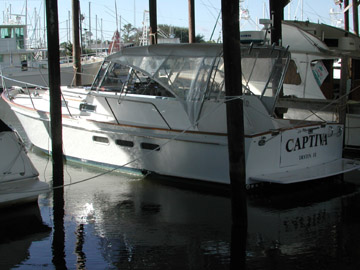
| LOA | 34' | Power | Cum 330 |
| Beam | 12'5" | Options | Unk |
| Draft | 3'6" | ||
| Displ. | 16,500 | Top Speed | 28-29 kts |
| Fuel | 251 gals | Cruise | 23-24 kts |
The post WWII baby boomer generation was the last generation to have any familiarity with traditional boat design, and therefore later generations are usually bereft of knowledge or experience of what the old geezers refer to as "real" yachts.
Nevertheless many of the younger generations have already been through two or three modern style boats and have found themselves displeased with both quality and performance. It is for that reason that interest in more traditional styles of boat building is growing, for after one has been through a few Carvers, Sea Rays, Cruisers, Inc., et. al. one is apt to be inclined to expand his horizons in search of something a bit better, most particularly in terms of all-around performance.
This is indeed a good thing, for the designs of yesteryear have a lot to offer. This is not to suggest that you should have a hankering for everything about the good-old-days, for not everything about that bygone era was good. As today, some designs of old were good and some were truly awful. The grass is not always greener on the other side.
* * * * *
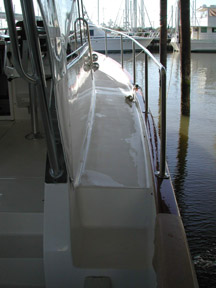
Extra wide side decks make
for easy navigation.
This is the first "down east" type boat that we've been able to do a review on, but certainly not the first we've surveyed. As a type, the down east style - for those of you who aren't familiar with them - are based on any number of New England work boat designs, mainly lobster & fishing boats commonly called down easters.
It is a style that is rapidly gaining in popularity, though most are built by small builders as custom or semi-custom high-end boats as this one is. Even those who produce the style in production, only do so in rather small numbers, in large part because people who favor these boats are generally those that demand quality and sea worthiness.
There is some modification of the traditional downeaster type, which usually have convex rounded stem lines and much lower transoms. Here we've got a hint of a clipper bow and a huge what is called a "transom stern". Add to that the raised bulwarks and what we have here is a design that is cross between a sailboat and a work boat above the water line, but pure work boat below.
The hull designs of these boats are not unique, nor are they uncommon. Their hulls almost always have very deep fore foots that usually flatten out at the stern to nearly no dead rise whatsoever. But even at the midpoint of the hull, the bottom will be steeply angled -- a design that comes as close as humanly possible to giving the best of both worlds, speed, a good ride and fuel economy. So efficient is this hull shape that these boats can be powered with single engines and still attain respectable speeds (It's not unusual that a boat this size cruises at 20+ knots with a single diesel engine.)
The style can have round or hard chines or even a modified chine -- round tapering into a hard chine. They nearly always have keels, some very deep and some shallow. Yet despite their traditional design, these boats tend to be quite beamy. A drawback of the style comes into play with the very sharp entry with a hull that in plain view is sort of rain drop shaped and not leaving a lot of room for a forward cabin.
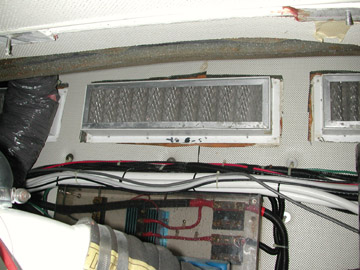
Large vents and lots of acoustic insulation in the engine room. Note the clear Lexan cover over bus panel.
The hull of the Legacy 34 has beautifully graceful lines from the up-sweeping shear line, almost clipper style bow and Hinckley-like forward cabin trunk replete with half-round teak molding. The only thing that disturbs the harmony of lines on this boat is the exceedingly large and tall stainless steel windshield that, like on many of the older Tiaras, is completely out of sync with the rest of the boat. Obviously, the designers decided that staying dry in a small boat took preference over style and grace.
I can't fault that as we headed out into the bay with a 30 knot wind out of the north and a very nasty chop at about 1-1/2 feet putting a white froth on the water's surface. The ride was exactly what I expected it to be as we barely noticed the chop at any speed. With those high winds one would expect to take considerable spray but the flaring bow kept it down, though I'd have to say that these conditions probably weren't a fair test.
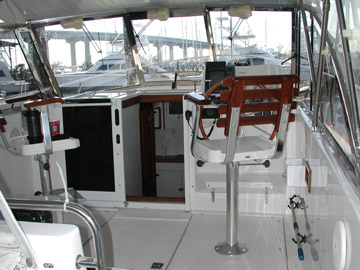
Mid cockpit is plenty spacious even with two pedestal chairs; high windshield keeps you dry and out of the wind.
Powered with Twin Cummins 5.9L diesels these engines are a good fit and a good match for this boat. As for speed, I clocked 28.6 knots upwind and 27.9 downwind at WOT and a respectable 23 knot cruise. As one might expect, this low profile doesn't create a lot of wind resistance but the winds at sea trial time were around 25-30 kts. Most New England work boat styles, when powering up from idle, will produce no notable transition from displacement to planning speed; the transition is completely smooth with no sudden rising up of the bow as the hull struggles to rise up on the surface. That's a function of the deep entry and flat stern sections.
As for the Legacy 34, I felt that the center of gravity was a little far aft as there was a noticeable transition as the bow rose slightly, and then settled back down. Extension of trim tabs would level her out to a 5 degree angle of attack. Even so, the overall performance was excellent by any standard.
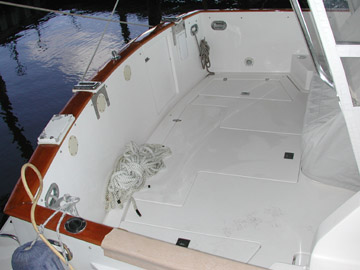
Even the aft cockpit is adequately sized - for fishing or swimming or whatever. Door opens onto platform.
Most notable to the type, at cruise speeds the hull does not skip over the tops of waves. Instead, the sharp, deep entry knifes through and parts them, yielding a much softer ride; none of that slam bang stuff of wave against hull. Of course, once you speed up, the hull will rise up higher and then some slamming will begin. But rest assured, that this boat will slice through stuff you wouldn't dream of tackling in any of those boats that look like something out of an old Buck Rogers comic book (allusion intentional).
While the engine room appears to be very well insulated, noise levels in the cockpit were measured at 84 dbl versus 104 with the hatch open; compared with the 104 dbl. noise of some boats, that's fairly quiet.
And speaking of the engine room, this is a pretty happy affair with quite good access from a large centerline hatch in the cockpit. There are three hatches total, but the two outboard hatches are a bit of a project to remove, requiring removal of both helm seats, big bolts and the L-shaped settee on the port side. Standing in the open hatch, the space is mid chest deep rendering a comfortable crawl space below with adequate space between the engines to be able to turn completely around. Only a defensive tackle would have trouble down here. I didn't lose any skin, end up with a bolt stuck in my skull, nor did any profanity issue from my mouth after spending nearly an hour down there, plus more time during the sea trail. All boats should be like this one.
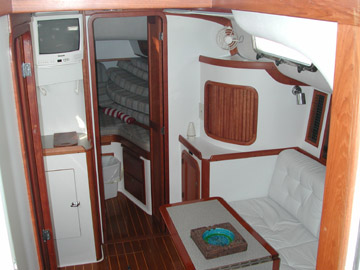
Vee berth cabin has adequate head room even above the berths. Galley is to the left with convertible L-shaped settee opposite (see below).
Sea strainers, valves. oil and fuel filters are easy to reach and service, but the batteries outboard of the engines less so. Mechanics will have little difficulty doing major repairs or servicing. The only problem I found was that the oversize engine room vents were bringing in a bit too much salt as they lack dorade boxes to keep salt spray down. despite coarse screen filters.
For those of you who like to be able to walk around the decks with ease, you'll love the very wide side decks which are what. . . . . 16 - 18 inches? I didn't measure, but it's a lot wider than than anything ever seen in a boat this size, and all that without making the cockpit seemed cramped. I could literally run from stern to bow aided by an unusually high railing. There are slightly raised bulwarks - about 8" at the bow, tapering back to 2" that render a nice "shiply" sense along.
* * * * *
On the inside it's got a very nautical, traditional look and ambience what with lots of teak trim around white mica surfaces; gleaming white and very salty looking. It shouldn't be any surprise to say that it might remind you of a sail boat interior; coming from a former sail boat builder (Freedom Yachts) and it shows. I found it delightfully refreshing after being subjected to so many Miami Beach Moderns and the ostentatious pretentiousness of so many recent boats.
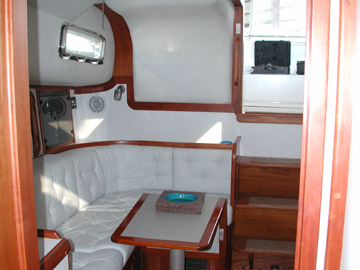
And while you may wonder why so much of the teak trim has screw heads showing, while you might not like screw heads, this is significant from the standpoint that trim can be easily removed for refinishing. Not an insignificant point for a boat that will clearly be around for a few decades at least.
Did I say all teak? Well, in looking over the woods used, I see teak and something else that I'm not sure what kind of wood it is, but is clearly not teak. Then there are the impressive and gleaming solid stainless steel port holes that let in an amazing amount of light that reflects off the white mica, making for a very bright interior even with only a small amount of light. Note that this boat was photographed under cover and yet it was still bright inside.
Refridgeration is no chintzy Norcold unit but a Gruenert DC compressor (in the engine room) with custom stainless steel box, both top and front loading with freezer section.
I could go on an on, but now that you've got a taste of the sauce, your guess about the remainder of the entre would be right on. What's under her skirt does not disappoint. Salty, very salty. Traditional but still modern. Rugged, durable, but not maintenance free, either. Some craft are mere boats but this one deserves the title of yacht. And like all real yachts, this one will either take a bit of elbow grease or few bucks over and above what it takes to keep a standard Clorox bottle boat.
Accommodations are a bit tight for a 34 foot boat what with only a vee berth cabin and convertible settee, but as is said ad nauseaum, what you get at one end of the stick, you lose on the other. In this case, you trade an auditorium interior for sea worthiness. I'd call this either a day boat or a good boat for one couple only in the over nighting department. A kid or two might be OK, but two couples over a weekend? Un Unh. Unless you're into being real close. But that large cockpit with good seating makes for a decent party boat and general entertaining.
For production-run boats, this comes close to as good as it gets.
Posted February 28, 2003
 Visit davidpascoe.com for his power boat books
Visit davidpascoe.com for his power boat books 














David Pascoe is a second generation marine surveyor in his family who began his surveying career at age 16 as an apprentice in 1965 as the era of wooden boats was drawing to a close.
Certified by the National Association of Marine Surveyors in 1972, he has conducted over 5,000 pre purchase surveys in addition to having conducted hundreds of boating accident investigations, including fires, sinkings, hull failures and machinery failure analysis.
Over forty years of knowledge and experience are brought to bear in following books. David Pascoe is the author of:
In addition to readers in the United States, boaters and boat industry professionals worldwide from nearly 80 countries have purchased David Pascoe's books, since introduction of his first book in 2001.
In 2012, David Pascoe has retired from marine surveying business at age 65.
On November 23rd, 2018, David Pascoe has passed away at age 71.
Biography - Long version